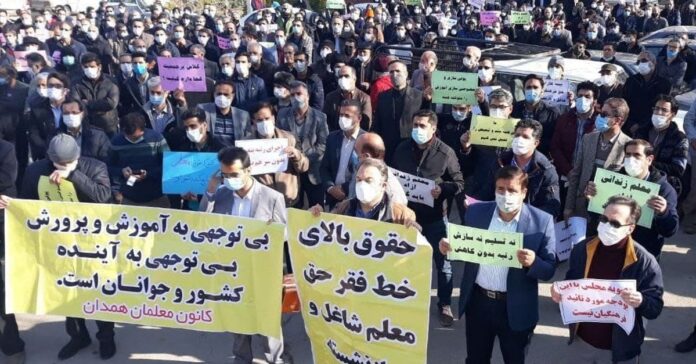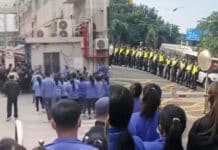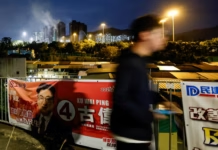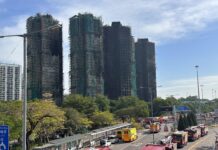The Iranian regime is in an unstable situation, they fear a new wave of generalized protests which is why they have increased repression in the last months.
Nina Mo, Socialist Left Party (ISA in Austria)
On 23 December 2021, a national day of action, tens of thousands of teachers and retired teachers — with women workers at the forefront — protested in over 100 cities in Iran, demanding higher wages, a decent and free education system and more. The workers protest at low wages, unpaid wages, a lack of medical insurance, repression and low pensions. The wages of Iranian teachers are mostly below the poverty line, which is a huge problem with rising inflation. Many teachers have to do a second or third job. The protests show the way forward for the working-class movement in Iran — particularly because of their strong organization. The “Coordination Council of the Iranian Teachers’ Trade Union confederation” called on all teachers to protest and to express their demands all over the country.
Continued protests
Protests in the education sector have been going on for months and years now, led mainly by independent and combative teacher’s associations and unions. The day of action on 23 December was a reaction to the regime’s new law to restrict strikes and protests, and was also against an inadequate pay rise which won’t be enough to cover teachers’ needs, as well as against the new budget which includes new cuts and austerity measures.
Nationwide strikes were held on the 11 and 12 December. The next day they turned into big protest rallies, in which not only active teachers but also retired teachers took part. The protests spread to more than 200 cities across Iran. In Isfahan alone, over 10,000 teachers participated in a rally with the main slogans pointing towards the repression and arrests: “Imprisoned teachers should be released”. Due to the catastrophic economic and living situation, which is reflected in the high prices of goods, teachers find themselves in an extremely difficult situation.
After months of protests, the parliament finally approved the so-called “Teachers’ Ranking System Bill” on 15 December. They suggested that the teachers’ demands had been met and there was no room for protest anymore, but the teachers announced that they would continue their protests. The teachers’ demands include a pay raise to reach 80% of the salary of higher education teachers, the immediate release of imprisoned teachers and trade unionists, and retired teachers who want their pensions balanced with the new inflation rates. All of that is being ignored by the regime.
The bill seeks to increase the teachers’ salaries by a small percentage, even though they have remained low for ten years. However, due to inflation, this salary is still below the poverty line. And the budget is not sufficient to raise wages. In the 2021–22 budget, the budget for ‘civil affairs’ including education is less than $3.5 billion, while the budget of the so-called Defense Forces is more than $5.08 billion! Mohammad Habibi, the spokesman of the Coordination Council said after the approval of this bill in the parliament: “The totality of what was approved in the parliament cannot be approved by the teachers in any way.”
Brutal repression
At the last big round of protests and strikes in mid-December, security forces attacked the teachers in a number of cities and arrested some leading activists. In total, over 200 teachers and trade unionists were arrested. The regime is in an unstable situation, they fear a new wave of generalized protests which is why they have increased repression in the last months.
Protesters chanted the regime’s response as “shameless” at the rallies, while authorities beat and temporarily detained several teachers’ representatives in front of the parliament building, including Rasoul Badaghi, the teachers’ union inspector, and threatened to fire others. However, fearing a backlash to Badaghi’s arrest, authorities were forced to release him a few days later.
The protests on 23 December took place despite officials and security forces texting teachers, warning them of the consequences in the days before! In Tehran, the regime tried to disperse the teachers as they exited the subway stations, but they gathered after leaving the stations. In Shiraz too thousands of teachers resisted the strong presence of the security forces. According to published reports, in Baharestan Square in Tehran, officers attacked male teachers to disperse them, but female teachers sat in the middle of the square and continued to sit in the square for about an hour, despite being attacked by security officers.
Organization and leadership
The big strength of the teachers’ movement is in its unity, organization and leadership. The recent strikes and protests were the best organized since years. Unlike other, very spontaneous struggles, the Coordination Council campaigned in the weeks before to mobilize and organize workers, even amongst regime-led unions. It seeks to organize rank and file teachers and radical trade unionists, unifying them under common demands for a decent education system in the interest of teachers and students.
With their combative approach, the leadership of the teachers’ association shows the necessary willingness to win the demands. The Coordination Council has emphasized in a recent resolution that “it will not stop demanding until the demands are fully met and will continue the protest process with the utmost intensity.”
Teachers in Iran have always been part of the most combative, politicized and leading workers who show the way forward in the struggle against the regime. It is necessary for their leadership to express this radical mood in their programme. The Coordination Council itself claims that they aren’t political — but it is absolutely clear that the teachers’ struggle is a political threat to the regime!
As the independent trade union of the Haft Tappeh workers wrote in their solidarity statement: “We should not have any illusions about the constitution, the labor law, and the small and large members of parliament and government institutions. We must dismantle this group with our independent organizations, with the help and support of the community.”
It is necessary for the teachers’ movement and especially the leadership to think of strategies to address the whole working class to support their struggle. For example, the active presence of students in some cities and an emphasis on a unity of students and teachers is necessary to expand the struggle. This unity is needed to win and expand the demands for a democratically controlled and organized education system, independent from religious institutions and the regime. In order to win, rank and file teachers must have full control over strategy, tactics and programme of the movement. The unions must be built in a democratic manner and push back any attempts from the regime to infiltrate them or their leadership.
General strikes as a next step to build a political struggle against the regime
The teachers’ struggles are part of a broader picture — in the last months and years numerous workplace struggles and strike actions have taken place — from miners to oil workers, bus and transport workers etc. In the last months, farmers, workers and the poor protested in a number of cities against water shortage and the impacts of the climate crisis.
All these struggles need to be linked in order to build a powerful and unified movement against the regime and the capitalist system. They show the real power of the working class to take over production and build a new society. This power could be used in the next, escalating steps to build a real threat to the regime: A general strike of all the different sectors to link up economic and political demands. It is clear that the corrupt and criminal regime is opposed to workers’ and farmers’ interests. It is only in opposition to the regime that the demands of teachers, farmers, oil workers and youth can be met.
It is extremely important and positive that over 43 independent unions have expressed their solidarity with the teachers’ struggle. This kind of working-class solidarity is what we have seen over and over again in the last years. The next important step would be to bring together all these different associations and unions and rank and file workers through a democratic national committee of different strike committees and unions — not only to coordinate actions but as a step to build a new independent working-class party with a bold leadership around a socialist programme to demand living wages and pensions, the renationalization of the big companies under worker’s control and to bring down the regime.




